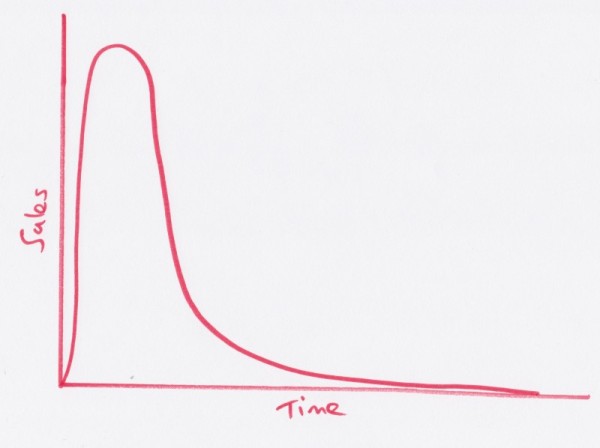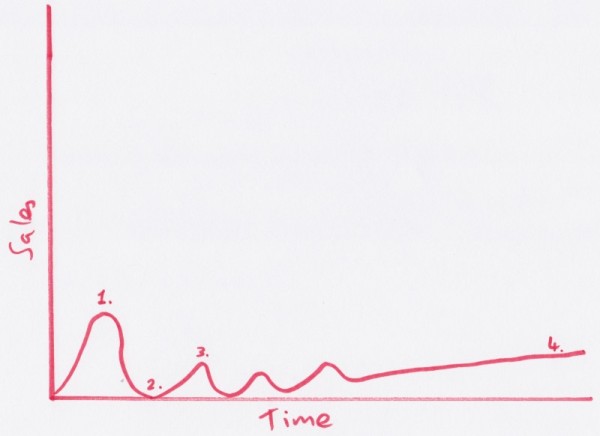Many (many) years ago I spent three years at university learning various business related topics. One of my favorites was always marketing, because it is basically creative writing but with more pictures. Marketing is typically associated with advertising, but the general concepts are highly transferable to many aspects of running a small business, including Indie Authors (who are effectively sole traders). I thought I would share some of these concepts for those who haven’t had any formal exposure to them. Note that I am under no illusion that I am Don Draper, in fact most of the lessons I am sharing are ones I had to learn the hard way! Let’s start with everyone’s favorite topic, sales.
The Sales Curve
You have likely heard this expression before, but what exactly does it mean? Put simply it is your sales charted out over a period of time. Typically when we think of a sales curve we think of something like this:
I am sure you are hoping to see a sales curve like this when you release your indie masterpiece. Unfortunately this type of sales curve is typically reserved for blockbusters, be they movie, games or books. There is an intense amount of marketing (ie hype) before launch and in a very short space of time after launch there is a large spike in sales. This high sales volume continues for a brief period as the product is reviewed and talked about by early adopters, with word of mouth (hopefully) continuing to drive sales. Sometimes the sales spike itself becomes news worthy and generates more media interest and sales, think of all the movies that broke ‘boxoffice records’ on their opening weekend.
Before you get too excited about this curve lets do a quick reality check. If you are an Indie author, particularly if it’s your first novel, it’s highly unlikely your sales curve is going to look anything like that. Perhaps the shape will be similar, but the numbers on the left hand side will be very different! It’s important to recognize this fact so you aren’t discouraged by your sales results. Let’s looks at a more realistic Indie sales curve:
Let’s examine some of the components in more detail:
- Friends and Family spike: You have managed the impossible and finished writing your book. You release it into the wild to spread its wings and bring in enough money so you can retire early. Unless you’ve done a whole lot of pre-marketing your early purchasers are likely to be people you already know, friends and family looking to support you in your new endeavor. They will hopefully tell their friends, post about it on their facebook pages etc, which will help to drive some initial sales. As your sales tally continues to grow you will feel unstoppable, until…
- The Valley of Despair: One minute you are on top of the world, eagerly refreshing your sales totals every day (ok fine, every five minutes) to see what new number appears. Then one day out of the blue that number stops increasing, and it is likely to drop all the way to zero new sales for a while. Why is this? Well primarily because no matter how good your book is people don’t just drop whatever it is they are doing to read it. In fact there’s a good chance your book is in a queue behind several other books on their ‘to-read’ list, and so it could be weeks before your initial customers read your book and get around to telling anyone else about it. Your novel isn’t a hilarious 30 second YouTube clip featuring cats and so it isn’t going to go ‘viral’ in the space of a few hours. Don’t panic though, the fact that five star reviews aren’t springing up mere days after your initial sales spike is not a bad sign. Go grab yourself a cup of tea and a good book and prepare yourself for the stakeout.
- Marketing spikes: If you get bored of waiting for the millions to roll in you may decide to do some marketing. This could take many forms, maybe guest posts on blogs, getting some decent exposure on review websites, promotional days with a heavy discount, traditional print or social media advertising and so on. Note that these spikes can also be caused by outside influence, perhaps someone with a lot of followers Tweeted about your book, or maybe Oprah mentioned it? If you see these types of spikes you should try to investigate what caused it, perhaps Oprah would love to have you on her show and you just need to know to ask! Whatever the cause these spikes will help generate a larger pool of people to talk about your book, which will help a lot in the next phase…
- The Long Tail: The long tail is a term that refers to those sales that continue long after your book was released. Now this is where things get interesting for Indies. We may not blast all our sales out in the first few days, but we have the potential for a more sustainable sales curve where we move a handful of copies every day. The gradient and length of the Long Tail will ultimately determine how profitable your book is. Assuming people are generally positive about your story it should create a virtuous circle of people enjoying your work, telling their friends, a few of whom buy it, enjoy your work and so on. The great news is that this positive association should be somewhat transferable, so the next book you release will have a higher initial spike as more of your fans buy it upon release. Before you know it you’ll be well on your way to that blockbuster sales curve! Having several books in the ‘long tail’ part of the cycle will also provide a steady income.
So that’s everything you need to know about Sales Curves, I hope it helped. If I’ve missed anything please feel free to chip in below, or let me know if you have any questions.




Makes a lot of sense. Appreciate the insight.
Hope it helped!
Thanks for the input. It is helpful!